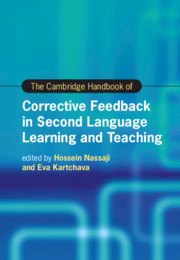2 results
Introduction - Corrective Feedback in Second Language Teaching and Learning
-
-
- Book:
- The Cambridge Handbook of Corrective Feedback in Second Language Learning and Teaching
- Published online:
- 26 February 2021
- Print publication:
- 11 March 2021, pp 1-20
-
- Chapter
- Export citation

The Cambridge Handbook of Corrective Feedback in Second Language Learning and Teaching
-
- Published online:
- 26 February 2021
- Print publication:
- 11 March 2021

